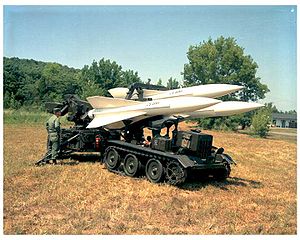skip to main |
skip to sidebar
RSS Feeds
6 Day War weapon, time-line, videos etc
6 Day War weapon, time-line, videos etc
7:22 AM
Posted by Peace Keeper
| MIM-23 Hawk | |
|---|---|
 MIM-23 Hawk | |
| Type | Surface-to-air missile |
| Place of origin | United States |
| Service history | |
| In service | August 1960 - present |
| Production history | |
| Manufacturer | Raytheon Corporation |
| Unit cost | $250,000 per missile $15 million per fire unit $30 million per battery |
| Specifications | |
| Weight | 1,290 pounds (590 kg) |
| Length | 16 feet 8 inches (5.08 m) |
| Diameter | 14.5 inches (370 mm) |
| | |
| Warhead | 119 pounds (54 kg) blast fragmentation warhead |
| | |
| Engine | solid-fuel rocket engine |
| Wingspan | 3 feet 11 inches (1.19 m) |
| Operational range | 15 mi (24 km) |
| Flight ceiling | 45,000 feet (14,000 m) |
| Speed | >Mach 2.4 |
| Guidance system | Semi-active radar homing |
| Bofors 40 mm gun | |
|---|---|
 Bofors 40 mm/L60. This example includes the British-designed Stiffkey Sight, being operated by the aimer standing to the right of the loader (turned sideways). It operates the trapeze seen above the sights, moving the sights to adjust for lead. | |
| Type | Autocannon |
| Place of origin | |
| Service history | |
| In service | 1934–present |
| Used by | See users |
| Wars | World War II, Indo-Pakistani wars and conflicts, Arab-Israeli conflict, Korean War, Indonesia-Malaysia confrontation, Vietnam War, South African Border War, Falklands War, Gulf War, Yugoslav wars, Iraq War, Lebanese Civil War |
| Production history | |
| Designer | Bofors |
| Designed | 1930 |
| Manufacturer | Bofors (1932–2006) BAE Systems AB (2006 onwards) |
| Produced | 1932–present |
| Variants | See 40 mm L/70 |
| Specifications | |
| Weight | L/60: 1,981 kg (4,370 lb) L/70: 5,150 kg (11,400 lb) |
| Crew | dependent on use |
| | |
| Shell | Complete round: - L/60 40x311mmR (1.57 in), L/70 40x364mmR |
| Caliber | 40 mm L/60-70 (actual caliber varies from 56-70, based on model) |
| Carriage | 522 kg (1,150 lb) |
| Elevation | L/60: -5°/+90°(55°/s) L/70: -20°/+80°(57°/s) |
| Traverse | Full 360° L/60: 50°/s L/70: 92°/s |
| Rate of fire | L/60: 120 round/min L/70: 330 round/min |
| Muzzle velocity | L/60: 881 m/s (2,890 ft/s) L/70: 1,021 m/s (3,350 ft/s) |
| Maximum range | L/60: 7,160 m (23,490 ft) L/70: 12,500 m (41,000 ft) |
| S-75 Dvina (NATO reporting name: SA-2 Guideline) | |
|---|---|
 S-75 including V-750 missile on camouflaged launcher | |
| Type | Strategic SAM system |
| Place of origin | |
| Service history | |
| In service | 1957-present |
| Used by | See list of present and former operator |
| Wars | Vietnam War, Six-Day War, Cold War, Iran-Iraq War, Gulf War, War in Abkhazia (1992–1993) |
| Production history | |
| Designer | Lavochkin OKB |
| Designed | 1953-1957 |
| Produced | 1957 |
| Number built | Approx 4600 missiles produced |
| Variants | S-75 Dvina, S-75M-2 Volkhov-M, S-75 Desna, S-75M Volkhov, S-75M Volga |
| ZSU-57-2 (Ob'yekt 500) | |
|---|---|
 ZSU-57-2 at the Lubuskie Military Museum in Drzonów, Poland, 1 July 2007. | |
| Type | Self-propelled anti-aircraft gun |
| Place of origin | |
| Service history | |
| In service | 1955 – Present (before the beginning of the 1970s in the USSR) |
| Used by | See Operators |
| Wars | See Service history and Combat history |
| Production history | |
| Designer | Design Bureaus of Omsk Works No. 174 and Research Institute No. 58 in Kaliningrad, Moscow Oblast |
| Designed | 1947–1954 |
| Manufacturer | Omsk Works No. 174 |
| Produced | 1957 - 1960 |
| Number built | More than 2,023 (USSR) 250 (North Korea, old turrets on new hulls) ? (PRC, Type 80) |
| Specifications | |
| Weight | 28.1 tonnes |
| Length | 8.46 m with gun in forward position (6.22 m hull only) |
| Width | 3.27 m |
| Height | 2.71 m 2.75 m (with a tarpaulin top) |
| Crew | 6 (commander, driver, gunner, sight adjuster and two loaders) |
| | |
| Armor | 8-15 mm |
| Primary armament | 2 x 57 mm L/76.6 S-60 anti-aircraft autocannons (57 mm S-68A twin anti-aircraft autocannon) (300 rounds) |
| Engine | V-54, 12-cylinder 4-stroke V-shaped airless-injection water-cooled 38.88 liter diesel 520 hp (388 kW) at 2,000 rpm |
| Power/weight | 18.5 hp/tonne (13.81 kW/tonne) |
| Suspension | individual torsion bar with hydraulic shock absorbers on the first and last road wheels |
| Ground clearance | 425 mm |
| Fuel capacity | 830 l (including two externally-mounted fuel tanks, 95 l each) |
| Operational range | 420 km (road) 320 km (off-road) |
| Speed | 50 km/h (31 mph) (road) 30 km/h (off-road) |